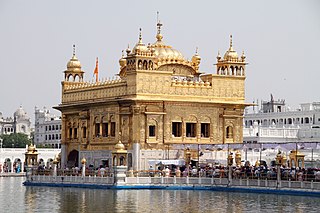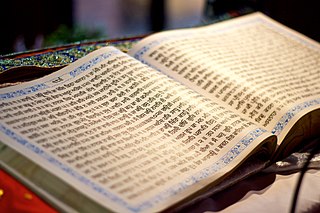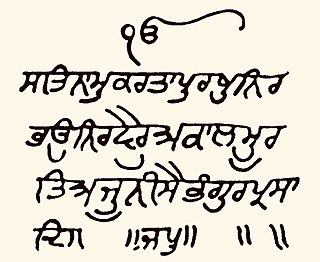
Sikhism, also known as Sikhi, or Sikh Dharma, is an Indian/Dharmic religion and philosophy that originated in the Punjab region of the Indian subcontinent, around the end of the 15th century CE. It is the most recently founded major organized faith and stands at fifth-largest worldwide, with about 25–30 million adherents.

Gauri is an India musical raga that appears in the Sikh tradition from northern India and is part of the Sikh holy scripture called Sri Guru Granth Sahib. Every raga has a strict set of rules which govern the number of notes that can be used; which notes can be used; and their interplay that has to be adhered to for the composition of a tune. there are Gouris of the Bhairav, Poorvi and Marwa thats with additional qualifiers such as the Shree-anga Gouri, Bhairav-anga Gouri, Poorvi-anga Gouri and so on. These are not considered ‘big’ ragas.

Guru Angad ; Gurmukhi: ਗੁਰੂ ਅੰਗਦ, pronunciation: [gʊɾuː əŋgəd̯ᵊ]) was the second of the ten Sikh gurus of Sikhism. After meeting Guru Nanak, the founder of Sikhism, becoming a Sikh, and serving and working with Guru Nanak for many years, Guru Nanak gave Lehna the name Angad, and chose Angad as the second Sikh Guru.

The Guru Granth Sahib is the central holy religious scripture of Sikhism, regarded by Sikhs as the final, sovereign and eternal Guru following the lineage of the ten human gurus of the religion. The Adi Granth, its first rendition, was compiled by the fifth guru, Guru Arjan (1564–1606). Its compilation was completed on 29 August 1604 and first installed inside Golden Temple in Amritsar on 1 September 1604. Baba Buddha was appointed the first Granthi of the Golden Temple. Shortly afterwards Guru Hargobind added Ramkali Ki Vaar. Later, Guru Gobind Singh, the tenth Sikh guru, added hymns of Guru Tegh Bahadur to the Adi Granth and affirmed the text as his successor. This second rendition became known as the Guru Granth Sahib and is also sometimes referred to as the Adi Granth.

Gurbani is a Sikh term, very commonly used by Sikhs to refer to various compositions by the Sikh Gurus and other writers of Guru Granth Sahib. In general, hymns in the central text of the Sikhs, the Guru Granth Sahib, are called Gurbani. Among Amritdhari Sikhs, a few texts from Dasam Granth which are read as Nitnem, like Tav-Prasad Savaiye and Chaupai, are also considered Gurbani. In Adi Granth, Gurbani is a sound which comes directly from the Supreme and the text is a written form of the same in worldly language and scripts. It is also called Guru´s Bani. Gurbani are explanations of qualities of the Primal Lord and Soul which a Sikh should comprehend and with which they can attain the supreme state.

Japji Sahib (Punjabi: ਜਪੁਜੀ ਸਾਹਿਬ, pronunciation: [d͡ʒæpʊd͡ʒiː säːɦɪb]) is the Sikh thesis, that appears at the beginning of the Guru Granth Sahib – the scripture of the Sikhs. It was composed by Guru Angad, and is mostly the writings of Guru Nanak. It begins with Mool Mantra and then follow 38 paudis (stanzas) and completed with a final Salok by Guru Angad at the end of this composition. The 38 stanzas are in different poetic meters.

Sukhmani Sahib, known under the title of Gauri Sukhmani in the scripture, is usually translated to mean Prayer of Peace is a set of 192 padas present in the holy Guru Granth Sahib, the main scripture and living Guru of Sikhism from Ang 262 to Ang 296. This Gurbani text was written by the 5th Guru, Guru Arjan (1563–1606) at Amritsar in around 1602. Guru Arjan first recited the bani at Gurdwara Barth Sahib in the Gurdaspur district of Punjab, India.

Ik Onkar, also spelled Ek Onkar or Ik Oankaar ; literally, "one Om", hence interpreted as "There is only one God or one Creator") is a phrase in Sikhism that denotes the one supreme reality. It is a central tenet of Sikh religious philosophy.

The Mūl Mantar is the opening verse of the Sikh scripture, the Guru Granth Sahib. It consists of twelve words in the Punjabi language, written in Gurmukhi script, and are the most widely known among the Sikhs. They summarize the essential teaching of Guru Nanak, thus constituting a succinct doctrinal statement of Sikhism.
In Sikhism, the Five Virtues are fundamental qualities which one should develop in order to reach Mukti, or to reunite or merge with God. The Sikh Gurus taught that these positive human qualities were Sat (truth), Daya (compassion), Santokh (contentment), Nimrata (humility), and Pyaar (love).

The principal Sikh scripture is the Adi Granth, more commonly called the Guru Granth Sahib. The second most important scripture of the Sikhs is the Dasam Granth. Both of these consist of text which was written or authorised by the Sikh Gurus.

In Sikhism, God is conceived as the Oneness that permeates the entirety of creation and beyond. It abides within all of creation as symbolized by the symbol Ik Onkar. The One is indescribable yet knowable and perceivable to anyone who surrenders their egoism and meditates upon that Oneness. The Sikh gurus have described God in numerous ways in their hymns included in the Guru Granth Sahib, the holy scripture of Sikhism, but the oneness of formless God is consistently emphasized throughout.

Nanakpanthis, also known as Nanakshahis, are terms that refer to followers of a Sikh sect who follow the teachings of and revere Guru Nanak (1469-1539), the foundational guru of a spiritual community natively known as Nanakpanth.

Gurū Nānak, also referred to as Bābā Nānak, was the founder of Sikhism and is the first of the ten Sikh Gurus. His birth is celebrated worldwide as Guru Nanak Gurpurab on Katak Pooranmashi, i.e. October–November.

"Guru Maneyo Granth" refers to the historic statement of the 10th Sikh Guru, Guru Gobind Singh (1666–1708) shortly before his demise on affirming the sacred scripture Adi Granth as his successor, thereby terminating the line of human Gurus. Installed as the Guru Granth Sahib, it is now the central holy scripture of Sikhism, and the eternal living Guru of all Sikhs. It is central to Sikh worship as it is said to imbibe the one light of the creator manifested in the Ten Sikh Gurus‐one spirit in ten forms.

Amrit Velā does not refer to a specific time. According to the pahar system of time, most Sikhs typically interpret this time to start at around 3:00am. Guru Nanak in the Japji Sahib says, "in amrit velā meditate on the grandeur of the one true Name". The importance of Amrit Vela is found throughout the Guru Granth Sahib. The Guru Granth Sahib states that "those who consider themselves a Sikh must wake up daily at Amrit vela and be in tune with the Naam "

The Guru Granth Sahib, is the central religious text of Sikhism, considered by Sikhs to be the final sovereign Guru of the religion. It contains 1430 Angs, containing 5,894 hymns of 36 saint mystics which includes Sikh gurus, Bhagats, Bhatts and Gursikhs. It is notable among foundational religious scriptures for including hymns from writers of other religions, namely Hindus and Muslims. It also contains teachings of the Sikh gurus themselves.

Sidh Gosti is a famous spiritual interfaith dialogue between Guru Nanak and Hindu Siddhas. The composition is present from page 938 to 946 in Adi Granth. Composition have 73 Stanzas, written in Ramkali Raga. Prominent Sidh and Naths present during discussion were Charpatnath, Bhangarnath and Loharipa . The popular belief is that this discourse happened at Achal Batala. Other than that Guru Nanak had discourses with Sidhas at various places mainly at Gorakhmatta, Achal Batala and Mount Meru. The discussion explains differences of Gurmat with Yog.
Suhi, a very old North Indian raga.: it also appears in the Sikh tradition from northern India and forms part of the Guru Granth Sahib. In the Guru Granth Sahib, the composition appear in 62 ragas and this is the thirty first raga to appear in the series. The composition in this raga first appear on Ang number 728.

Rama, known as Ram Avatar or Raja Ram, is considered an important figure in Sikhism, due to his inclusion as one among the 24 incarnations of Vishnu in the Chaubis Avtar, a composition in the Dasam Granth traditionally and historically attributed to Guru Gobind Singh. The discussion of Rama and Krishna is the most extensive in this section of the secondary Sikh scripture. The composition is martial, stating that the avatar of Vishnu appears in the world to restore good and defeat evil, but asserts that these avatars are not God, but agents of the God. God is beyond birth and death. The famous Savaiya and Dohra from the Rehras Sahib, read daily be devout Sikhs, comes from Ram Avtar Bani.
















